A sampling of other interesting frequency results for the temple at Medinet Habu (see a previous post on this topic here):
• Sandals are worn by the king in 129 of the 765 scenes:

• A sunshade is held in conjunction with pharaoh in only 28 instances:
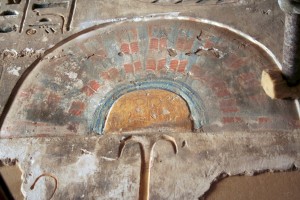
• A shebyu collar is worn by the king in over half the scenes (407):
• Pharaoh wears a shendjet kilt on 49 occasions
• There is near parity in the number of times the king wears a khepresh crown (197) and the nemes headdress (193)
Khepresh crown:
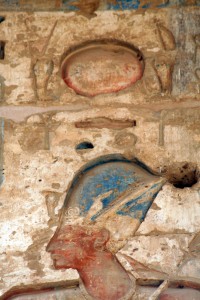
Nemes headdress topped by an atef crown:
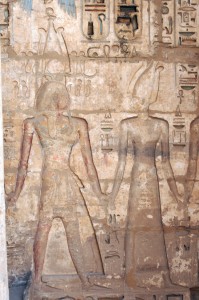
• Pharaoh sports one of the crowns related to Upper and Lower Egypt (the desheret, hedjet, or sehemty) in 136 scenes. Other headgear are utilized far less frequently, such as the lappet wig (74 scenes), round wig (50), and atef crown (25).
Round wig:
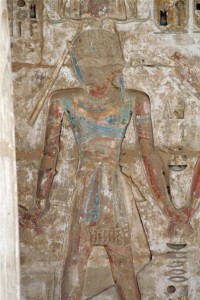
• Manacled foes appear in 14 scenes:

• The king is depicted seated 22 times:
• The king stands within a shrine in 17 instances
• The king offers to an ithyphallic god on 44 occasions:

This list represents only a few of the frequency results—if there is a particular attribute you are interested in at Medinet Habu that you would like more information on, please comment on this post or contact me at amy@artofcounting.com

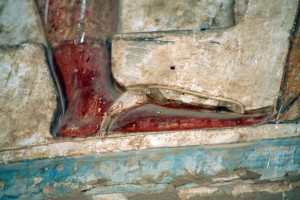
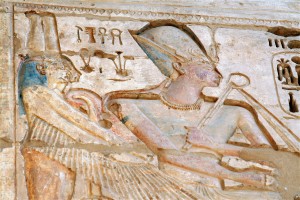
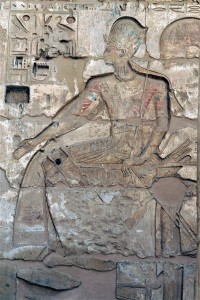

How often does the king appear offering to dieties with other deities by his side? Is there a breakdown by deity? Thank you for the very interesting compilation.
Hello Brian,
Thank you! I will create a separate article based on your very insightful request. The current version of the database has a few of the deities tracked separately. A new version of the database is in the works that will have full breakdowns and allow searches for single, multiple, or ‘merged’ deities (Amun-Re-Kamutef, for example)–if the Kickstarter funding effort is successful, I hope to have the 2.0 version of the database developed by early fall. Should be able to get an answer to your question up within the next day or so–I would like to give you credit by name for bringing this topic to my attention, if that would be okay.
Thank you again!
Your post is an inspiration for me to study more about this issue. I must concede your lucidity widened my views and I will forthwith snatch your rss feed to remain up to date on any incoming articles you might issue.
This is really a great blog posting and very helpful. I truly appreciate the study you put into it
Dear Amy Calvert,
What a wonderful eye-opener your site is :v) I truly didn’t imagine how counting stuff would reveal so much new and exciting information. I wonder if you do counting-requests? As I am currently studying Egyptian votive statuary and offerings (mostly LP bronzes) for my MA I’ve been wondering what kinds of offerings are depicted on temple walls. I haven’t been able to find any offerings of votive statuary – unless you include the King offering Maat in the palm of his hands – and there’s no evidence that’s even a statue.
But the topic of offerings in temple reliefs seems rather neglected in egyptology – so if you one day find yourself at a loss as to what to count I suggest the types of offerings shown on offering tables, being carried by Nile-god, sprinkled and poured by pharaoh and so forth. I’d love to know what types of offerings are more or less used: bread, fowl, flowers, incense etc.
In any case keep up the good work!
Kind regards, David
Dear David,
Thank you so much for your kind comments on this effort and for your continued interest in this project. Even after using this approach for several years now, it continues to amaze me how much counting can reveal as well! Your research sounds very interesting–I’ll check at Medinet Habu; there may be statuary offerings there of the king, as part of the prenomen being offering a la Ma’at, although it is hard to say whether they would have been really considered votives.
The topic of offering scenes has been rather neglected to date, but I am delighted to tell you that one of the collaborators on this project, Katherine Eaton, has been busily investigating Ramesside offering scenes in an effort to quantify the appearance of various offerings. She will soon have access to our next version of the database to enter that material, making it infinitely easier to perform this kind of research.
As to your project, please feel free to contact me via email (amy[at]artofcounting[dot]com) and I will be happy to search the database for you. We currently have the entirely of Medinet Habu, and I tracked the occurrence of many offerings; it literally takes 2 seconds to find out how many milk (or wine, or Ma’at, or bread, or vegetation, etc.) offerings there are and where they are located within the temple. Our eventual goal is to make the database available online for people to search on their own, but we’re not quite there yet.
Thank you again for your comments. May your research go smoothly!
Best,
Amy